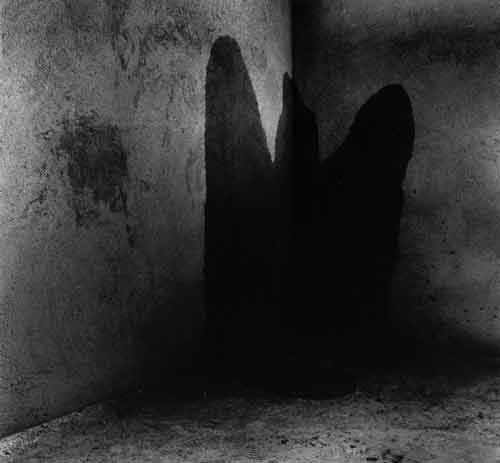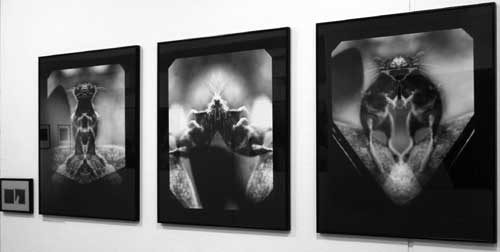 |
|
 Untitled, black and white photograph, 1993, 70/100 cm
 Untitled, black and white photograph, 1993, 70/100 cm
|
|
|
A Mystery in the Centre of Rationality
|
|
|
We are probably the last witnesses of the dying mystery of the world doubled by images (and perhaps we may only vaguely recall it). [...] These registrations do not allow me to forget an enormous power and responsibility being an immanent attribute of any process of reproducing reality. There is something magical in it: to understand them, one has to believe in importance and grimness being a part of any action of creating pictures of reality - these words of Piotr Wołyński introduce us right in the middle of his fascination of the phenomenon of creation of the photographic image. Despite the fact of quoting this process twice, in his artistic search, the author starts from ordinary, rational aspects of this process. His works are leading us unnoticeably through the border, which results to be only a thin line - distinguishing an area of sure and clear knowledge from an unknown and not named. Despite the fact that he twice refers to magical aspect of this process, the author in his artistic search starts always from ordinary, rationally perceptible aspects of this process. His works are leading us unnoticeably through the border - which results to be only a tiny line - separating an area of sure and clear knowledge from a zone of unknown and unnamed. In reality, it is quite different: Piotr Wołyński shows us, that outside of a limit, but in the middle of rationality, there is an astonishing and unexplained mystery, which we cannot perceive in our every day relations with reality.
After more than 160 years from inventing photography, a process of making photographs, seems to be as ordinary and obvious as a vision itself. Therefore, Piotr Wołyński assumes as a point of departure actions conformable with these obvious things. Being guided by basic, knowledge from optic's classes knowledge, that the rule of building an image is the same for a camera and for an eye - he introduces a second photographic image and puts it over the first one, similarly to what happens with two eyes vision. There appear "Casual Forms" (Mimoforms), strange objects, which are an effect of summarizing into one image registrations from two identical negatives, showing the same object. Fantastic, one may thing coming from another Universe creatures, appearing on the photos, arise our suspicion that the world we may see with our two eyes, it is maybe equally strange construction which has nothing to do with a real shape of reality. Finding another explainations of existence of this slit between the world and its image, we question an obvious belief of an immanent identity of photographic image with a visual one. If - let's assume a reverse situation - our direct vision is in it's nature adjacent to reality, therefore, in our momentary registration of the "portrait of light" on silver emulsion of the film appears an image of totally different kind. This is an image evoking grimness with its uncanny features. These registrations do not allow me to forget an enormous power and responsibility being an immanent attribute of any process of reproducing reality. There is something magical in it: to understand them, one has to believe in importance and grimness being a part of any action of creating pictures of reality. This astonishment and sensation of grimness appears in the photographers mind. He expresses it not only in words but also in his comments. In strange way it has it's source in compatibleness of the rules for construction of photo-camera to the objective features of the world. It comes out of conviction, that images "create themselves", since possibility of their appearance is enclosed in rules governing reality, Therefore, the world itself has features of duplication and reproduction in subsequent shadows, reflections, reversed images from camera obscura. A multiplicity of these reflections, diversity of its character prove, that in reality, we don't ever get a knowledge of a "true reality" - we are only wandering between its different shapes and new and new incarnations. It becomes for us an impassable jungle of possibilities, the deep, out of which appear new and new chimeras. The "apotropaic objects" in the title are according ethnological terminology, means serving for magical protection against evil, spirits, nature and people. For Piotr Wołyński photography is a magical protective spell. The subsequent pictures, revealing lack of a stable character of reality, its amorphism, liquidity and "transparency" - impossibility to catch "an ultimate picture" - they do stop something, they create in this grim depth some fixed and unchangeable point. What was once recorded on scratch of the sensitive paper - is constant and is not a subject to metamorphoses. A photographic image, registering on the same film two mutually excluding stats of things, as it happens in the cycle "Transparency (action in front of photo-camera)" reveals "strangeness" (as it was called by Witkacy) of reality, a co-existence in it of many parallel worlds, and at the same time it tames this reality by enclosing it in one piece of paper. However, the private apotropaic objects of Piotr Wołyński always show its two sides: when we would like to see in it an ordinary piece of paper, they instantly draw us into the depth of an unknown space; when we become frighten by its weirdness - they calm us down, telling us that it is only a surface of a sensitive paper. The series of works made with pinhole camera, is in case of Piotr Wołyński an action of totally different kind that recently wide-spread use of this tool in order to return "to the sources" of photography. Here, to say the truth, one wands also return to sources, but meant in totally different way: Because these actions call for aesthetics accompanying the beginnings of photography - there are supposed to omit everything what from then on, within a realm of aesthetics of photography came into existence since then. In his works Piotr Wołyński uses the first and basic one , and intentionally omitted feature of the process of creating pictures in camera obscura. He pays particular attention to the fact that in reality, in the dark room there is created not a one picture, as one may think, when we take into consideration a further development of photographic technology - but unlimited number of pictures, appearing in each point of the box with hole. This is reality itself, using put on its way objects, produces unlimited copies of itself; creates new spaces, spaces of images. A First Communion picture of a boy with a candle in his hand - a standard frame of unprofessional photography - in the pinhole version of Piotr Wołyński becomes "A Cognizance" and "A Good Lord's Trap"; an encounter of two mirror realities and manifestation of striking, casual correspondence of forms, which take place within, and which are visible only on the picture. In the pinhole photographs of this author, it is manifested an astonishing for a contemporary viewer truth, that creation of virtual realities, possible thanks to the newest digital technologies, there is nothing new. In the very similar way, reality itself, making use of its well known and obvious features, creates these pictures in the ordinary box of a pinhole camera. Furthermore - these pictures are carrying a message of mysterious nature of surrounding us space, a message the ordinary digitally manipulated pictures are deprived of. The works of Piotr Wołyński are using a photographic image as a tool for studying a nature of reality. A fascination with this image and a process of its creation has its source not in the attitude of an analytical scientist, but in the attitude of an artist astonished by unexpected forms in which reality manifests itself in individual and personal cognizance, involving not only a rational mind, but also an emotional feeling. Referring to photography in its rudimentary rules, to photography meant as an element of nature rather than culture, the author of works realizes to himself an audience, a very important truth of need for humility with regard to still unknown mysteries of nature. |
|
Elżbieta Łubowicz, april 2003
|
|

The Cognizance, black and white pinhole photograph, 1998, 70/95 cm
|
|

|
 |
|
from the series: Casual Forms of Stone Statute, black and white photograph
|
|

|
|

from the series: Casual Forms, black and white photograph
|
|

 from the series: Temporary Objects, black and white photograph, 20/20 cm, 2002
|
|

 view of exhibition
|
|
|
Copyright ©2003 Galeria FF ŁDK, Piotr Wołyński, Elżbieta Łubowicz.
|
|